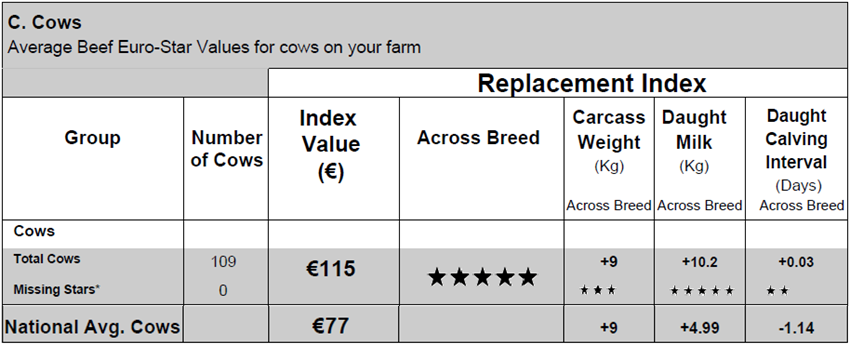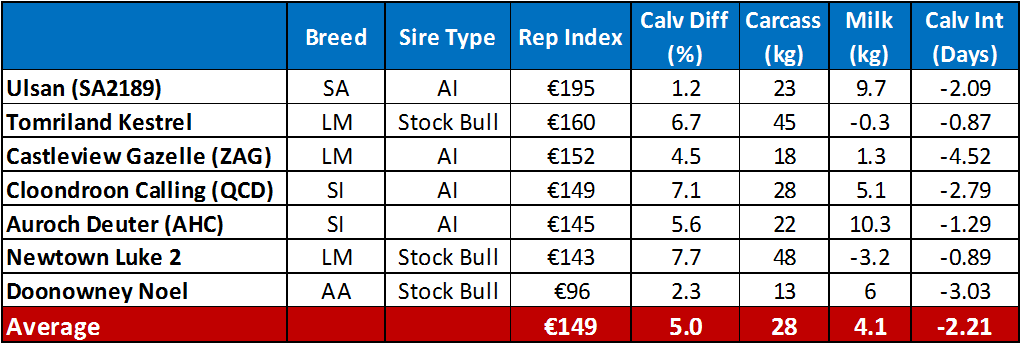Tullamore Farm is a new suckler and sheep demonstration farm which has been set up by the Irish Farmers Journal as a means to demonstrate best practise for Irish beef and sheep farmers in areas such as breeding, grassland management, health and finance. An open day was held on Tues 25th July which saw over 3,000 people visit the new farm. ICBF was in attendance on the day with a HerdPlus stand taking queries from farmers. There was also a demo on best use of the Euro-Star Index as a breeding tool for suckler farmers.
High Replacement Index herd
A herd of approximately 110 suckler cows has been put in place on the farm. The herd has an average Replacement Index of €115 which places it in the top 5% of herds in the country (see figure 1). The national average Replacement Index is €77.

If we look beneath the surface of the Replacement Index we can see that this is driven primarily by a very high daughter milk figure of +10.2 kg (top 1%). The genetic merit of the herd for carcass weight (+9 kg) and daughter calving interval (+0.03 days) however, are average and below average respectively. It is clear from these figures that while the overall Replacement Index of the herd is very high, its genetic makeup is slightly imbalanced.
Achieving the right balance
A cow accounts for 50% of the genetic makeup of her calf, with the other 50%, of course, coming from the sire. Herein lies the solution. In order to bring more balance to the genetic makeup of the herd, suitable sires must be used. Table 1 details the sires used on Tullamore Farm for the 2017 breeding season.

The average Replacement Index of the team of sires used in 2017 was €149, which is €34 higher than the cow herd average. The critical factor though, is the makeup of this overall figure:
- Firstly, regardless of the production system, calving difficulty is something to be avoided. At 5% for calving difficulty, the team average is only slightly above the national average calving difficulty figure (4.5%).
- The carcass weight figure is +28 kg which is 19 kg above the cow herd average of +9 kg.
- The calving interval figure is -2.21 which is a 2.24 day decrease on the cow herd (a negative calving interval figure is desired).
- The milk figure is +4.1 kg. While this is a 6.1 kg decrease on the cow herd average it still leaves a positive progeny figure.
The team of bulls used should result in progeny with more balanced Replacement Indexes – improving on carcass and fertility and maintaining positive milk.
Applying to your herd
In order to get the maximum benefit from the Euro-Star index it needs to be interpreted and used properly at herd level. There are three simple steps to getting the most out of the index:
- What are the traits of importance for your herd? There are 17 traits in the Euro-Star Index. Different herds will require different traits depending on the production system. It is important for a herdowner to know exactly the traits of importance are for their herd.
- Where does your cow herd rank on these traits? Herdowners should use the HerdPlus Euro-Star report to establish the genetic merit of their suckler cows on the traits of importance for their production system. Look at the overall Replacement Index, but also assess the sub traits within the index e.g. carcass weight, milk and calving interval.
- Select bulls to improve on these traits. Genetic improvement is primarily driven by bulls. A suckler cow will only produce one calf per year. A stock or AI bull can produce a large number of calves, therefore a bull can leave a far greater imprint on a herd’s genetics in a much shorter period of time. A potential new stock bull or AI bull should always be superior to a cow herd average on the traits of importance for that herd.
Through improved interpretation of the Euro-Star index, farmers can gain maximum benefit from this important breeding tool. The ultimate aim is to breed a balanced suckler cow. Strong on important maternal traits (milk and fertility) as well as growth traits (carcass weight and conformation).For more information on the HerdPlus Euro-Star report call 023-8820452 or email [email protected].
